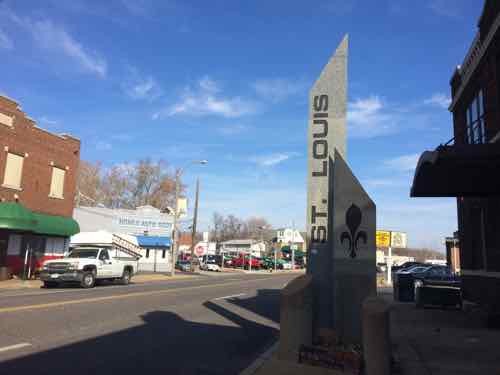The 1876 City Limits Were So Far Out In The Countryside
From its founding in 1764 the city limits of St. Louis kept expanding as the city grew in population. Each time they annexed land in the rural fields surrounding the city.
The 1860 census recorded 160,773 residents — more than 100% growth from 1850s census figure of 77,860. The 1870 census saw the population nearly double again — to 310,864 (Wikipedia). When St. Louis divorced itself from St. Louis County in 1876 the limits where set far out in the countryside. The leaders at the time must not have thought we’d reach those limits as quickly as we did, or leapfrog them as happened.

Though Maplewood wasn’t incorporated until the 20th century, people like James Sutton settled the area in the early 19th century decades before St. Louis split with St. Louis County. From Maplewood’s history:
In 1876, the limits of the City of St. Louis were extended to their present location. This limit line shows no consideration for the buildings in Maplewood, but ruthlessly bisects many of them. It cuts off the eastern triangle of the Brownson Hotel and runs right through the middle of the old Maplewood Theater, (now gone) putting the projection booth in Maplewood and the screen in St. Louis.
On one street, however, the limits do not interfere with the house. This is along Limit Avenue which was plotted with half of its width on either side of the limits line (St. Louis on the east and Maplewood on the west).
This divorce bought change to the county left behind:
When the new county was organized, a Maplewood man, Henry L. Sutton, son of James C., was chosen as its chief executive officer, or presiding justice of the county court. The first three meetings of this body were held at the Sutton home on Manchester. Then in 1877, the patriarch of the neighborhood, James C. Sutton died. He left nine children and his land was divided between them. One of the daughters, Mary C. Marshall, seems to have been the first to think of selling her tract for a subdivision, for in 1890, she sold to a company organized by Theophile Papin and Louis H. Tontrup, two St. Louis real estate men, and managed by Robert H. Cornell.
If only we could bring the 1870s leaders into the present day to show them the consequences of their actions. If so, St. Louis would likely be part of St. Louis County with limits out near the present-day I-270.
— Steve Patterson
Ahh, yes, the clarity of 20/20 hindsight . . . . “If only we could bring the 1870s leaders into the present day to show them the consequences of their actions.” After 145 years, that would hold true for every city, every state and every national legislative body, anywhere! The populations, demographics, economics, politics, transportation options, industrial processes, religious institutions, communication options and financial realities, along with different, changing, evolving priorities in every arena, were very different in the 19th Century than they are in the 21st. What would actually be more useful woud be to grade our leaders 20 years and 40 years later, and hold them somehow accountable, while they’re still alive and can see the true consequences of their choices. Second guessing the actions of someone, anyone who has been dead for more than a century is about as useful as judging somone from 2, 3, 5 or 8 centuries prior – it’s called history – different times, different priorities, different choices. Yes, if we don’t study and learn from history, we’re doomed to repeat it. But part of understanding and learning from history is context. The reasons for the “Great Divorce”, like many, many other things in politics, boils down to money (taxes) and power: http://blogs.riverfronttimes.com/dailyrft/2010/05/the_great_divorce_everything_you_ever_wanted_to_know_about_the_city_county_split.php . and for that very reason, getting back together has been, and will continue be, very difficult to make a reality!
From the person who constantly brings up unintended consequences…
The history of Maplewood seems to forget that the Maplewood Theatre, with the booth in Maplewood and the screen in St. Louis was built in the 1920s…long after the City/County divorce.